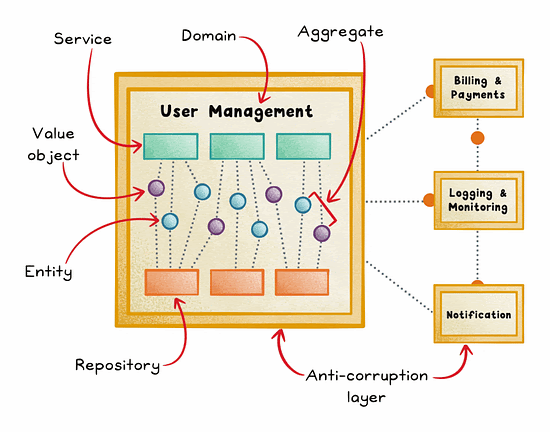Domain-Driven Design Demystified: Bridging Development and Business Needs
(5 Minutes) | How It Works, Benefits, Drawbacks, When It Shines Best
Get our Architecture Patterns Playbook for FREE on newsletter signup:
GitLab Duo - Your Secret to Faster Deployments
Presented by GitLab
Accelerated Coding: Get intelligent, real-time code suggestions, regardless of your current platform.
Improved Code Quality: Generate tests and understand complex code faster with AI-powered explanations.
Enhanced Security: Proactively identify and address potential security vulnerabilities within your code.
Simplified Collaboration: Streamline code reviews and improve team efficiency with AI-generated summaries.
Check out how GitLab Duo can help your team code and deploy faster.
Domain-Drive Design Demystified
Software that seamlessly integrates with business domains brings a strong set of benefits to an organization.
It can streamline operations, enhance user-centric features, and provide stakeholders with real-time insights for quick, well-thought decisions.
Domain-driven design is a software development approach that excels at providing this alignment between domain experts and developers, bridging the software's functionalities directly with the business's needs.
Let’s explore how DDD achieves this integration.
How Domain-Driven Design Works
To closely align software development with underlying business needs, DDD structures complex systems around the business domain, using a model that evolves over time through collaborative efforts between domain experts and software developers.
This approach helps create software that is both functional and meaningful, effectively reflecting and supporting business activities.
Below are some of the key concepts and components integral to DDD, each playing a specific role in crafting a coherent and effective system:
Bounded contexts
This foundational DDD component defines a specific domain's limits where a common model and language are shared. It’s a logical boundary in which the terms are consistent.
Isolating domain terms prevents overlap and ensures consistency across various application components.
By clearly defining these contexts, DDD helps teams to work more independently on the same system, reducing the risk of miscommunication.
Ubiquitous language
This is developed between developers and domain experts to ensure all communications are precise and use the same terms and phrases.
It mitigates technical jargon ensuring accessibility to domain experts and stakeholders. This common language is used consistently across the entire project, minimizing misunderstandings.
Entities and value objects
Both play crucial roles in ensuring the domain model captures the business needs accurately.
Entities are objects that have a distinct identity that runs through time & different states.
Value objects describe a characteristic but lack a conceptual identity.
Entities are mutable whereas value objects are immutable.
Aggregates
These are clusters of domain objects (entities & value objects) under an aggregate root that can be treated as a single unit. They provide a mechanism to manage & enforce consistency within a bounded context.
They aim to reduce interdependencies and aid in enforcing domain rules, contributing to a more organized domain model.
Domain events
Significant business events that trigger transactions or changes within the domain. These events help make implicit concepts explicit and are integral to modeling business processes.
Repositories
Mechanisms that encapsulate the storage, retrieval, and search behavior, emulating a collection of domain objects. Repositories manage data access and abstract it from the domain model.
Context mapping
A strategic design decision that deals with how different bounded contexts communicate and integrate with one another.
It’s essential for managing complex systems where multiple bounded contexts interact.
Anti-corruption layer (ACL)
A component used to translate between different bounded contexts, preventing one context from negatively affecting another and maintaining the integrity of each bounded context’s model.
Domain-driven design's components and concepts are intricately linked to form a comprehensive approach that tightly aligns software development with business needs.
Bounded contexts define clear boundaries within which specific domain models operate, ensuring clarity and consistency.
Ubiquitous language enhances communication across teams, minimizing misunderstandings.
Entities, value objects, and aggregates organize the domain model while maintaining data integrity and enforcing business rules.
Domain events and repositories facilitate dynamic responses to business changes and manage data interactions efficiently.
Context mapping and the Anti-corruption Layer strategically manage interactions between different bounded contexts, preserving each context’s integrity.
Collectively, these components work synergistically to create robust, adaptable systems that reflect and evolve with the business domain, promoting efficiency and effectiveness in software solutions.
The Upside
Domain-driven design brings with it some major benefits.
Just as a bridge connects two sides, DDD ensures alignment between software development and business domains.
Through clear domain models, DDD encourages flexibility providing a foundation that can be more amenable to changes, aligning with the evolving business requirements.
By establishing a shared language, domain-driven design helps reduce knowledge gaps between devs and domain experts, improving collaboration.
While these are some of DDD’s primary benefits, they are by no means comprehensive. Other upsides include improved maintainability, reduced complexity, consistency and integrity, and more.
The Downside
As you know, there is no perfect methodology, and domain-driven design is no exception.
It involves significant initial overhead, as defining accurate contexts and detailed models can delay development start. In saying that, the long-term benefit of simpler complexity management is the major gain from this price to pay.
For less intricate domains, it can be overkill. It adds a layer of complexity as It requires a steep learning curve & rigorous discipline.
Without ongoing collaboration with domain experts, domain-driven design risks misalignment, leading to solutions that drift from business realities and prove less effective.
A few other noteworthy drawbacks of DDD include rigidity in large teams, resource intensiveness, and the potential for siloed development.
Where DDD Shines Best
Complex systems
Domain-driven design is well-suited for environments with intricate business rules and complex domains. It aims to abstract these complexities into more manageable segments.
Large teams
DDD promotes a unified understanding across cross-functional teams, helping to align team members with the business’s goals.
Evolving businesses
For organizations undergoing rapid changes, domain-driven design provides a framework that can accommodate adaptations, reducing the potential for extensive reworks.
While domain-driven design is often not well suited for small projects due to its complexity and overhead, it is an excellent and popular choice for large, complex environments where its structured approach can significantly aid in managing intricate business rules and interactions.
Wrapping Up
Domain-driven design fosters collaboration between developers and domain experts, helping to design software that closely aligns with business needs.
It doesn't fit every scenario, but when it does, the impact is clear. Each project's unique demands dictate its suitability.
Subscribe to get simple-to-understand, visual, and engaging system design articles straight to your inbox:




